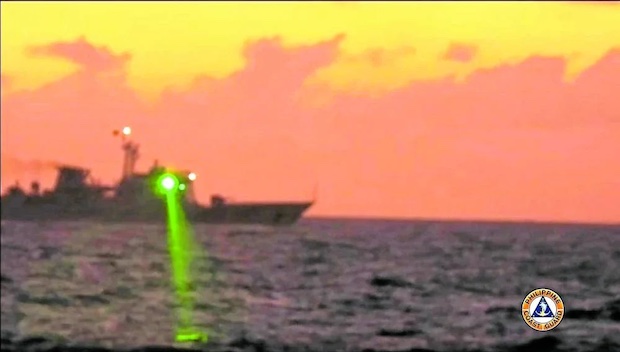
China Coast Guard Vessel No. 5205 is shown directing a laser beam at BRP Malapascua where this photo was taken on February 6, 2023. (Photo from the Philippine Coast Guard)
The China Coast Guard (CCG) dispatched two of its ships to a shoal within the country’s exclusive economic zone (EEZ) where a Philippine Coast Guard (PCG) vessel was ordering several Chinese maritime militia boats to leave, a PCG spokesperson said Thursday.
The BRP Malapascua (MRRV 4403) sent several radio messages to a group of at least 20 Vietnamese and Chinese fishing boats at Sabina (Escoda) Shoal during a patrol on March 16 telling them to leave before deploying several coast guard personnel on rigid hull inflatable boats to verbally give the order as they were in Philippine waters.
The Vietnamese complied but the Chinese, believed to be part of China’s maritime militia, stayed as one CCG vessel sailed to the area from Ayungin (Second Thomas) Shoal, and another was seen closing in, according to Commodore Jay Tarriela, the PCG spokesperson for the West Philippine Sea.
“That’s the first time that we encountered two China Coast Guard ships in Sabina Shoal. The implication that we see on this is that they are concerned that the PCG vessel would drive away the Chinese maritime militia,” Tarriela told the Inquirer. “It is alarming because they are coming close to our shores already.”
Sabina Shoal is 135 kilometers away from the nearest point in Palawan province.
Posing as fishers
Chinese militia vessels pose as fishing boats and work with the CCG to enforce Beijing’s territorial claims in the South China Sea, including the West Philippine Sea, waters within the country’s EEZ.
Chinese militia vessels have been “loitering” at Sabina Shoal in recent years. Last year, the Department of National Defense expressed “great concern” over the swarming by Chinese vessels of the shoal and the nearby Iroquois Reef.
The Malapascua was deployed to patrol the waters around the Kalayaan Island Group from March 16 to March 21.
Not budging
On the first day of its deployment, Malapascua encountered the Vietnamese and Chinese boats when it reached Sabina Shoal. A bigger CCG ship, with bow No. 5304, had sailed to the area.
“We decided to launch our rigid hull inflatable boats to drive them away. The Vietnamese complied but the Chinese coast guard, they did not move at all. They maintained their positions anchored in different places in Sabina,” Tarriela said.
After three to four hours of trying to expel the Chinese militia vessels, a second CCG vessel, with bow No. 5305, appeared. It came from Panganiban (Mischief) Reef, which the Chinese had turned into an artificial island and a major military outpost within the Philippines’ EEZ, Tarriela said.
The BRP Malapascua issued multiple radio challenges to the Chinese vessels to assert Philippine sovereignty in these waters. The Chinese coast guard responded by also claiming sovereignty over Sabina, known to them as Xian Bin Reef.
“Philippine Coast Guard 4403 you have entered the sea area under the jurisdiction of the People’s Republic of China. China has indisputable sovereignty over Xian Bin Reef and its adjacent waters and enjoys sovereign rights and jurisdiction,” the Chinese were heard saying.
More encounters
Over the course of Malapascua’s March 16-21 deployment, it encountered more Chinese vessels.
Off Pag-asa (Thitu) Island, the largest outpost occupied by the Philippines, a People’s Liberation Army-Navy Type 056A Jiangdao II-class missile corvette shadowed the Malapascua within the island’s 22-km territorial waters.
Radio challenges were exchanged, Tarriela said.
A Parola-class patrol ship, the Malapascua was the same vessel whose crew were temporarily blinded when CCG 5205 aimed a military-grade laser on it while it was supporting a resupply mission to the Ayungin outpost in early February. The Philippines filed a diplomatic protest against the Chinese action.
As it was sailing back to port, Malapasqua was shadowed by CCG 5201 from a distance of about 1.5 km. Both ships traded radio challenges.
At one point, the CCG vessel was caught changing its automatic identification system (AIS) information from CCG5201 to DONGYU1527-850% while tailing Malapascua.
The AIS, which transmits a vessel’s position so that they could be identified and located, is an international requirement for large ships. Naval vessels are exempted.
“It’s called spoofing. The ship is trying not to be identified,” maritime security expert Ray Powell told the Inquirer. “Changing AIS info in the middle of an engagement is pretty ham-handed (clumsy). … They are trying to confuse the PCG and downplay their presence.”
RELATED STORIES
Coast Guard bares new tack vs Chinese harassment in WPS
China harasses Philippine Coast Guard vessel with laser
Coast Guard finds claims of Chinese boat crew ‘suspicious’

